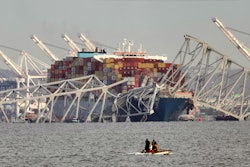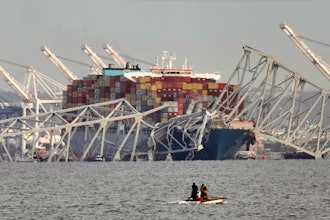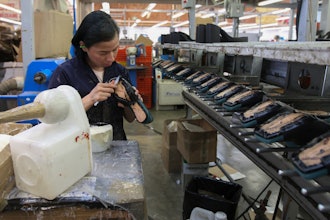
If the rapid shifts in manufacturing supply and demand have you feeling a bit whiplashed, it’s no wonder. Over the past 18 months, we’ve seen unprecedented supply chain volatility compressed into a relatively short period of time creating a new kind of bullwhip effect: large distortions in demand driven by a variety of factors across the entire supply chain.
Traditionally prompted by shifts in consumer demand at the end-user level, the snap of the bullwhip is now making its way further up the supply chain thanks to disruptions all around. From talent shortages and COVID-related slowdowns and lockdowns in Chinese manufacturing and sea ports to natural disasters like flooding and hurricanes to blocked shipping routes—not to mention everyone from consumers to manufacturers at all levels of the chain over-ordering to hedge their bets against future disruptions—the origin point no longer lies solely with the consumer. Now the chaotic reverberations seem to emerge at every link in the chain.
While none of these interruptions are new, it is unprecedented to have them stacked so tightly together in such a short span, and even more concerning is the fact that it’s not likely to end anytime soon. With new COVID variants spreading, the risk of localized lockdowns (particularly in China) and supply chain issues will continue. And that means manufacturers must take action now to calm the reverb. Here are four strategies to uncrack the bullwhip in your supply chain.
1. Communicate with suppliers
One of the biggest contributors to supply chain volatility is lack of communication. Worried about increasing demand forecasts, manufacturers place panic orders with their suppliers with zero insight as to whether they can even produce what they’ve asked for. This causes suppliers to panic order from their suppliers, and so forth up the chain. Instead, simply having a conversation with your suppliers about what’s realistic—or even necessary—can dramatically reduce the inflection points and stop the bullwhip before it wreaks havoc up the chain.
2. Diversify
In the Before Times, working with a single supplier was ill advised, but not exactly disastrous. But today, when a single positive COVID test can shut down an entire production line, it can be catastrophic, putting you essentially out of business if a critical supplier is unable to deliver. Diversifying your supply chain with more than one supplier for essential inputs allows you to balance order loads when hiccups happen, shifting demand away from suppliers with production slowdowns and toward those with greater capacity. Having this ability to shift on the fly not only keeps your business moving forward, but also takes the pressure off struggling suppliers so that they can stay online and get back on their feet.
3. Consider localization
With shipping challenges cropping up around the world, even if suppliers can make what you need, getting it to you might be impossible, or at least prohibitively expensive. We’ve talked to one manufacturer that used to get containers out of Asia for $4,000 each, and now those same containers cost $22,000—over 5X more. Shifting to local-sourced goods and raw materials can drastically reduce transportation challenges and costs. Even if the product itself costs a bit more, what you save in lost revenue prevention, transportation and downtime caused by shipping delays can offset any increase.
4. Leverage technology
Lack of visibility and control over supply chain processes can cripple production when a hiccup occurs. But having real-time insight into production capacity and how well you and your supplies are executing against production plans can help you forecast and react to issues before they become problematic. Implementing a supply chain control tower that includes integration up and down the supply chain can help you forecast realistically and shift on the fly as the situation demands. For example, with shipper integration, you can see just how delayed your container will be from that backed-up port and find alternatives, including evaluating the implications of making a change. Having this technology in place gives you the data you need to understand and get ahead of problems, rather than just sitting and waiting for them to resolve—or having to work endless hours trying figure it out and developing a plan to address it.
Rather than being a victim of circumstance, manufacturers that take proactive steps to minimize the bullwhip effect within their own supply chain can gain a competitive advantage, allowing them to meet demand expectations without overwhelming the system. This measured approach can help dampen supply chain volatility within your organization and across the board.
Time for a disaster-response approach?
While being proactive within your own organization is essential, it’s also worth considering whether it’s time for a broader scale disaster-response intervention. What’s happening in the supply chain has caused major disruptions to our economy, especially against the backdrop of COVID-related job losses, including price inflation that has strapped families in need of basic food and supplies. Why not initiate a federal disaster response? FEMA is quick to deploy the National Guard and other resources to move supplies in the wake of hurricanes, flooding and tornadoes. Might we leverage those resources now to get our supply chain moving faster?
We’ve just pulled 6,000 troops out of Afghanistan. Perhaps we should consider deploying those logistical teams at our shipping ports to drive trucks, unload ships, etc. Imagine the speed of supply chain recovery if the Chinese deployed just 25% of its military to backlogged shipping ports to load containers and get freight moving again.
I certainly wouldn’t recommend manufacturers sit back and wait for the government to help. But with manufacturing tied so tightly to public health, safety and our overall economy, perhaps it’s time we put public resources to work in resolving these issues of national economic importance.
 Koenemann
Koenemann






















